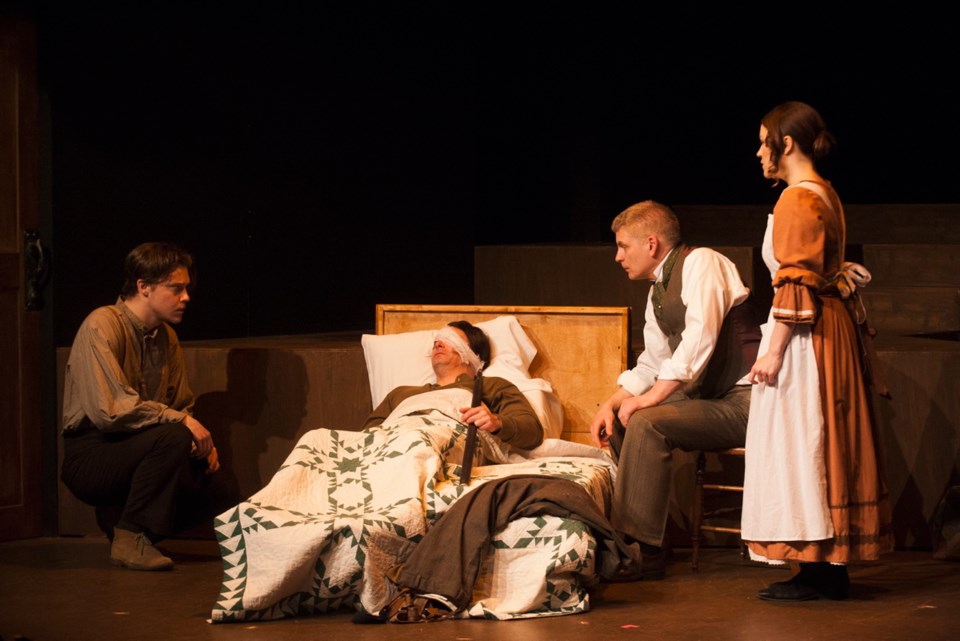His survival was an absolute miracle. In 1848, Phineas Gage worked with a blasting crew near the village of Cavendish, Vermont. A spark accidentally ignited a gunpowder charge, shooting a tamping iron through his skull.
The metal bar, which he later kept as a souvenir, pierced his brain. The wound became horribly infected — and 19th-century medical treatment was primitive. Amazingly, Gage recovered. His personality, however, was greatly changed. The previously hardworking, sober man became impulsive, childlike and prone to profanity. Gage lived for another dozen years, dying at 36. For a time, he earned a living as a medical curiosity at Barnum’s American Museum in New York.
Victoria playwright Janet Munsil explores the curious case of Phineas Gage in That Elusive Spark. The two-hour play, first staged at the University of Victoria’s Phoenix Theatre in 2005, has just opened at Langham Court Theatre.
The results are decidedly mixed — such a sprawling, complex work is an ambitious choice for community theatre. Still, those interested in this macabre medical footnote might want to seek out the play, a finalist for the Governor General’s Award in 2014.
Munsil leapfrogs back and forth in time from Gage’s tale to a parallel story: the modern-day experiences of Helen Harlow (Kassianni Austin). She’s a newly hatched neuropsychologist who happens to be related to the country doctor who treated Gage. Harlow, starting her new job teaching at a college, is also a mess — she’s a depressive 33-year-old virgin who once attempted suicide. She knows a lot about how the brain works but has precious little insight into her own dysfunctional life.
Helen lives in a student boarding house, where she meets Finlay (Thomas Miller), a cheerful slacker who likes beer … and Helen. Their fractious relationship functions as a romantic comedy, presumably to offset the morbidity of Gage’s tale.
Munsil poses the question: What makes us who we are? And beyond nature, to what extent do outside influences play a role? On one hand, we have poor Gage, trying to cope with catastrophic brain injuries. Meanwhile, Harlow — desperate to feel better and “normal” — experiments with a Soma-like pill that makes her more cheerful than Kelly Ripa at a baby koala’s birthday party.
�����������’s Hamlet surfaces as a central theme in That Elusive Spark. The references are plentiful. Harlow ostentatiously owns a human skull as a memento mori. Her father was a celebrated academic who specialized in Hamlet.
Quotes from Hamlet pop up relentlessly. For instance, Gage offers a snippet from Polonius’s “To thine own self be true” speech. A modern-day character plays Ophelia in a college production of Hamlet, and an old-timey character (both are played by Lianne Coates) dies an Ophelia-like death.
The success of the Hamlet counterpoint within the orchestration of That Elusive Spark is debatable. When it comes to searching for one’s true identity and purpose, it’s true the character of Hamlet ranks as a shining star. Yet at times, the Shakespearean subtext of this play has a self-conscious, rather tacked-on quality.
It’s an extremely complex work, much more ambitious in terms of structure than Munsil’s early plays, such as Emphysema and The Ugly Duchess.
Interestingly, That Elusive Spark bears a passing resemblance to David Auburn’s Proof (2000), another complicated drama. In that play — also replete with flashbacks — a gifted, troubled young woman grapples with her mental health and a conflicted love interest while operating in the shadow of her celebrated deceased father.
Making her directorial debut at Langham Court Theatre, Mercedes Bátiz Benét struggles to render That Elusive Spark into a coherent whole. The play features short, snapshot-style scenes that, on Thursday night, seemed clunky, with overly long gaps between each.
There is also a problem with the production’s overall tone. Some acting in contemporary scenes employed a broad, sitcom style seemingly at odds with the rest of the show, particularly the historical sequences.
It’s a challenge to create a set for That Elusive Spark given that it pole-vaults between time periods. Jason Vikse opted for a sparse, functional look. Unfortunately, it’s dominated by a curious-looking cylindrical black object that I initially though was the base of a giant palm tree or an industrial waste chute.
This is, it turns out, a giant tamping rod. Part of the problem is that it’s very poorly lit. Indeed, inadequate lighting dogs the production throughout.
Austin captured Helen Harlow’s brittle fretfulness, although she struggles to make her an empathetic character. Thomas Miller did well as her love interest Finlay, nicely portraying a floppy-haired doofus while also showing the character’s conflicted side.
As Phineas Gage, Trevor Hinton had strong moments, despite being saddled with an unfortunate wig. His most convincing turn, however, was the short sequence in which he’s a student playing Hamlet.
The most enjoyable piece of acting of the night was Christopher Mackie’s clever comic turn as an uber-happy physician on antidepressants. Mackie also did well as a phrenologist determined to capitalize on Gage’s misfortune.
That Elusive Spark continues at Langham Court Theatre to March 16.



